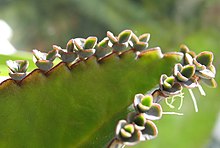Kalanchoe daigremontiana
This article needs additional citations for verification. (April 2010) |
| Kalanchoe daigremontiana | |
|---|---|

| |
| Young plants on leaf | |
| Scientific classification | |
| Kingdom: | |
| (unranked): | |
| (unranked): | |
| (unranked): | |
| Order: | |
| Family: | |
| Genus: | |
| Species: | B. daigremontianum
|
| Binomial name | |
| Bryophyllum daigremontianum | |
| Synonyms[1] | |
| |
Bryophyllum daigremontianum, also called mother-of-millions, mother-of-thousands, alligator plant, or Mexican hat plant is a succulent plant native to Madagascar. Like other members of its genus Bryophyllum, it is able to propagate vegetatively from plantlets that develop on its phylloclade margins. All parts of the plant are poisonous (they contain daigremontianin and other bufadienolides), which can even be fatal if ingested by infants or small pets.[2][3]
Taxonomy
Plants of the genus Bryophyllum have sometimes been included in the genus Kalanchoe, where this species is known as Kalanchoe daigremontiana Hamet & Perrier.
Morphology
Plants grow up to 1 m (3 feet) tall and have opposite and whorled, fleshy oblong-lanceolate phylloclades which grow up to 20 cm (6-8 inches) long and 3.2 cm (1.25 inches) wide. They are green above and blotched with purple underneath. Phylloclade margins have spoon-shaped bulbiliferous spurs which bear plantlets which may form roots while still attached to phylloclades.[4]
A plant may also develop lateral roots on its main stalk, as high up as 10–15 cm above the ground. A plant's upper phylloclades may grow large, causing its main stalk to bend downward. Then the lateral roots may enter soil and new vertical shoots may grow from the original shoot.
Bryophyllum daigremontianum has an umbrella-like terminal inflorescence (a compound cyme) of small bell-shaped, grayish pink (or sometimes orange) flowers. Flowering is, however, not an annual event and occurs sporadically if at all on some shoots. Particularly in climates with distinct seasonal temperature differences, flowering is most frequently observed at the beginning of a warm season. In Maryland, U.S., indoor plants begin flowering in early winter.
As a succulent plant, B. daigremontianum can survive prolonged periods of drought with little or no water. It is however not frost-hardy and typically dies if subjected to temperatures below freezing.
Physiology
Plants of the genus Bryophyllum as well as many other plants growing in arid regions photosynthesize through Crassulacean acid metabolism.
B. daigremontianum is toxic; it contains a cardiac glycoside - daigremontianin.
Distribution
B. daigremontianum is native to the Fiherenana River valley and Androhibolava mountains in southwest Madagascar. It has been introduced to numerous tropical and subtropical regions, such as Florida, Puerto Rico, Hawaii, and parts of the Canary Islands.
It can become an invasive plant an threaten natural ecosystems, specially in arid and semi-arid environments, where it can inhibit native-plant recruitment[5]
Gallery
-
Kalanchoe daigremontiana potted
-
Kalanchoe daigremontiana county distribution in Florida.
-
Flowers
-
plantlets
-
plantlets
References
- ^ "Bryophyllum daigremontianum factsheet". University of Queensland. Retrieved 12 January 2014.
- ^ Wagner, Hildebert; Fischer, Manfred; Lotter, Hermann (1985). "New Bufadienolides from Kalanchoe daigremontiana Hamet et Perr. ( Crassulaceae)" (PDF). Zeitschrift für Naturforschung B. 40 (9): 1226–1228. Retrieved 27 January 2016.
- ^ McKenzie, R. A.; Armstrong, T. R. (1986). "Poisoning of cattle by Bryophyllum plants". Queensland Agricultural Journal. 112 (3): 105–108. Retrieved 27 January 2016.
- ^ Batygina, T. B.; Bragina, E. A.; Titova, G. E. (1996). "Morphogenesis of propagules in viviparous species Bryophyllum daigremontianum and B. calycinum". Acta Societatis Botanicorum Poloniae. 65: 127. doi:10.5586/asbp.1996.022.
- ^ Herrera, Ileana; Ferrer-Paris, José R.; Hernández-Rosas, José I.; Nassar, Jafet M. (2016). "Impact of two invasive succulents on native-seedling recruitment in Neotropical arid environments" (PDF). Journal of Arid Environments. 132: 15–25. doi:10.1016/j.jaridenv.2016.04.007. Retrieved 6 May 2016.
Literature
- Everitt, J.H.; Lonard, R.L.; Little, C.R. (2007). Weeds in South Texas and Northern Mexico. Lubbock: Texas Tech University Press. ISBN 0-89672-614-2





